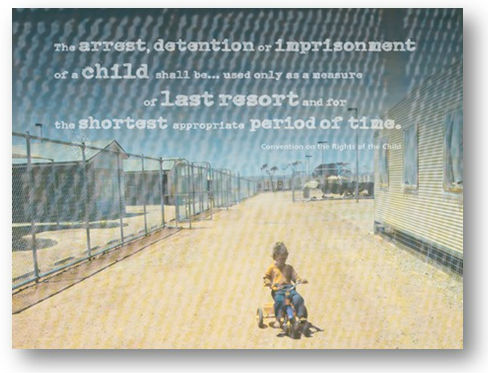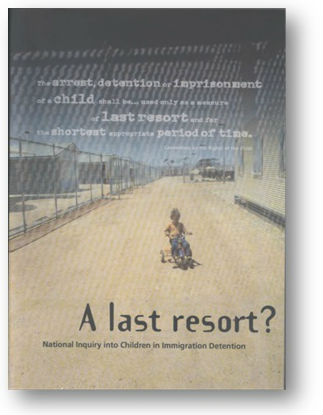Children in immigration detention page
back to immigration detention, asylum seekers and refugees
Under Australia’s system of mandatory immigration detention, all non-citizens who are in Australia without a valid visa must be detained. This includes children.
The vast majority of children who are in immigration detention are children who arrived in Australia by boat, seeking asylum. Some of them came with family members, but some of them came alone.
While there have been significant improvements over recent years, including the transfer of many children into community-based alternatives to closed detention, the Commission continues to have serious concerns about the impact of Australia’s mandatory immigration detention system on children.
On this page:
-
How many children are in immigration detention in Australia, and where are they detained?
-
What happens to unaccompanied children who arrive in Australia?
-
Are children subject to third country processing?
-
What does international human rights law say about the detention of children?
-
What does the Commission do to promote and protect the human rights of children in immigration detention?
-
What was the Commission’s report A Last Resort about?
-
What has changed since A Last Resort was published?
How many children are in immigration detention in Australia, and where are they detained?
The Department of Immigration and Border Protection publishes statistics setting out the number of people, including children, in immigration detention. As at 30 September 2013 there were:
- 1,078 children in closed immigration detention facilities, and a further
- 1,760 children in community detention in Australia.
For all the most recent statistics on immigration detention, including the numbers of children in detention, see immigration detention statistics.
The vast majority of the children who are in closed detention are held in low security immigration detention facilities. These include immigration residential housing in Sydney, Perth and Port Augusta, immigration transit accommodation in Melbourne, Brisbane and Adelaide and various ‘alternative places of detention’ (APODs) on Christmas Island and the mainland. Since June 2013 families with children have also been held in immigration detention facilities at Wickham Point in the Northern Territory which were only recently re-designated as an APOD.
What happens to unaccompanied children who arrive in Australia?
Asylum seeker children who arrive in Australia alone without a parent or guardian are subject to mandatory detention the same way accompanied children are.
Australia has obligations in relation to children who arrive in Australia unaccompanied, especially those who are seeking asylum, to ensure that they receive special protection and assistance. Australia has an obligation under the CRC to ‘ensure alternative care’ for these children.
An important element of the care of unaccompanied minors is effective guardianship. In the absence of their parents, the legal guardian of an unaccompanied minor has the ‘primary responsibility for the upbringing and development of the child’, and is under an obligation under the CRC to act in the best interests of the child. Under Australian law, the Minister for Immigration and Border Protection is the legal guardian of ‘non-citizen’ unaccompanied minors.
The Commission has a range of concerns relating to unaccompanied minors in immigration detention. Most significantly, the Commission is concerned that the Minister’s role as guardian of unaccompanied minors creates a conflict of interest, as the Minister is also responsible for administering the immigration detention regime under the Migration Act and for making decisions about granting visas. Given these multiples roles, it is difficult for the Minister, or his delegate, to make the best interests of the child the primary consideration when making decisions concerning unaccompanied minors.
The Commission has repeatedly recommended that an independent guardian be appointed for all unaccompanied minors in immigration detention, to ensure that their rights are protected.
Are children subject to third country processing?
Asylum seeker children who come by boat to Australia can be transferred to and detained in a third country (currently either Nauru or Manus Island in Papua New Guinea) under the Australian Government’s third country processing regime which was introduced in August 2012.
The Commission has strong concerns about the transfer and detention of child asylum seekers on Nauru and Manus Island. To read about the Commission’s concerns, see the Commission’s submission to the Parliamentary Joint Committee on Human Rights.
What does international human rights law say about the detention of children?
Australia ratified the Convention on the Rights of the Child (CRC) in 1990. One of the basic principles of the CRC is that the best interests of the child should be a primary consideration in all decisions that affect them.
The CRC sets out specific requirements to protect the liberty of children, including the requirements that:
- children must only be detained as a measure of last resort
- children must only be detained for the shortest appropriate period of time
- children should not be detained unlawfully or arbitrarily
- children in detention have the right to challenge the legality of their detention before a court or another independent body.
The CRC also provides that:
- children seeking asylum have a right to appropriate protection and assistance - because they are an especially vulnerable group of children
- children separated from their parents have a right to special assistance
- children in detention should be treated with respect and humanity and they have the right to healthy development and to be able to recover from past trauma
- children seeking asylum, like all children, have rights to physical and mental health; education; culture, language and religion; rest and play; protection from violence; and to remain with their parents.
What does the Commission do to promote and protect the human rights of children in immigration detention?
The Commission works in a number of ways to promote and protect the human rights of all asylum seekers, refugees, and people in immigration detention, including children. However, because children are vulnerable and are given special protection under international human rights law, the Commission has maintained a particular focus on the rights of children in its immigration detention work.
The Commission has conducted two national inquiries relating to children in immigration detention in Australia. The reports of these inquiries make recommendations to the Australian Government aimed at protecting the human rights of children. For further information see:
- A last resort? the report of the National Inquiry into Children in Immigration Detention (2004)
- Those who've come across the seas: Detention of unauthorised arrivals (1998)
What was the Commission's report A last resort? about?
Prior to 2005, hundreds of children and their family members were detained in remote immigration detention centres, some for months or years. Most of these children had arrived by boat and were seeking asylum in Australia.
The Commission was gravely concerned about the human rights of these children. In 2004, the Commission released A last resort? the report of the National Inquiry into Children in Immigration Detention. The Inquiry found that Australia’s mandatory immigration detention system was fundamentally inconsistent with Australia’s obligations under the CRC, particularly the requirement that a child should only be detained as a measure of last resort and for the shortest appropriate period of time.
The Inquiry also found that children who are detained for long periods are at high risk of serious mental harm, and that long-term detention significantly undermines a child’s ability to enjoy a range of human rights, including the right to education and the right to enjoy the highest attainable standard of physical and mental health.
What has changed since A last resort? was published?
Following the completion of the National Inquiry, there were two positive developments in Australia’s laws and practices regarding holding children in immigration detention.
Firstly, the Federal Parliament amended the Migration Act 1958 (Cth) in 2005 to affirm ‘as a principle’ that a minor should only be detained as a measure of last resort.
Secondly, the Australian Government gradually removed children from Australia's high security immigration detention centres, and moved significant numbers of unaccompanied minors and families with children into community detention.
However, today, children in Australia continue to be held in low security immigration detention facilities such as immigration residential housing, immigration transit accommodation and various ‘alternative places of detention’ on Christmas Island and the mainland.
The Minister for Immigration and Citizenship announced in May 2013 that high security immigration detention facilities on Christmas Island, at Curtin in Western Australia, and Wickham Point in the Northern Territory would be adapted in order to hold families with children. The Commission expressed significant concerns about this change in policy.
As at 13 September 2013, children were no longer being held in the Curtin immigration detention facilities. However, the Commission has numerous concerns about the conditions of detention in some of the facilities in which children are still held, including:
- the impact of detention in remote locations, including the harsh physical environment of the detention facilities at Leonora and Wickham Point
- the use of detention infrastructure and accommodation which is inappropriate for families and unaccompanied children due to a lack of open grassy spaces and inadequate indoor and outdoor recreation spaces, for example at Leonora, Darwin and the Construction Camp on Christmas Island.
- the lack of adequate access to education for children in detention in some locations
- the lack of suitable recreational opportunities for children in detention in some facilities.
In May 2013 the Australian Government announced that some asylum seeker families who are liable to transfer to a third country would be considered for the grant of bridging visas and allowed to live in the community while awaiting an outcome of their applications for Protection Visas.
The Commission welcomes the use of bridging visas as a more humane and effective approach to the treatment of asylum seekers than holding them in detention facilities for long and indefinite periods of time. However, it has significant concerns about the Australian Government’s decision to deny these asylum seekers –including families with children – the right to work while they are living in the community. For more information, see the Commission's factsheet Tell Me About: Bridging Visas for Asylum Seekers.
For more information about the Commission’s current concerns regarding children in immigration detention, see:
- Asylum seekers, refugees and human rights: snapshot report 2013
- Immigration detention on Christmas Island: Observations from visit to Immigration detention facilities on Christmas Island (2012)
- Immigration detention in Leonora, Western Australia (2011)



